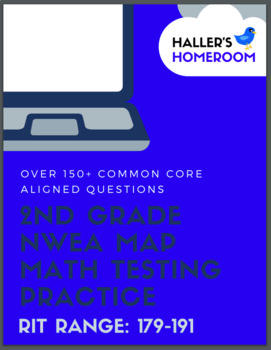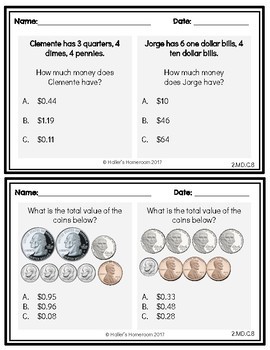2nd Grade NWEA MAP Math Practice Questions [RIT 171 -191]
- PDF
What educators are saying
Description
This product is designed to prepare your students for 2nd grade NWEA MAPs Testing. There are over 150 questions aligned to both NWEA Maps Math Test and 2nd Grade Common Core Math Standards. Use this product as quick and easy practice pages, exit tickets or whole group instruction. Enjoy all 35 pages of no-prep practice throughout the year! Also, includes answer key pages.
Integrates these Common Core 2nd Grade Math Standards:
Geometry:
2.G.A.1 -- Recognize and draw shapes having specified attributes, such as a given number of angles or a given number of equal faces. Identify triangles, quadrilaterals, pentagons, hexagons, and cubes.
2.G.A.3 --Partition a rectangle into rows and columns of same-size squares and count to find the total number of them.
Measurement & Data:
2.MD.A.1 -- Measure the length of an object by selecting and using appropriate tools such as rulers, yardsticks, meter sticks, and measuring tapes.
2.MD.A.3 -- Estimate lengths using units of inches, feet, centimeters, and meters.
2.MD.B.5 -- Use addition and subtraction within 100 to solve word problems involving lengths that are given in the same units, e.g. by using drawings (such as drawings of rulers) and equations with a symbol for the unknown number to represent the problem.
2.MD.B.6 -- Represent whole numbers as lengths from 0 on a number line diagram with equally spaced points corresponding to the numbers 0, 1, 2, …, and represent whole-number sums and differences within 100 on a number line diagram.
2.MD.C.7 -- Tell and write time from analog and digital clocks to the nearest five minutes, using a.m and p.m.
2.MD.C.8 -- Solve word problems involving dollar bills, quarters, dimes, nickels, and pennies, using $ and ¢ symbols appropriately.
2.MD.D.9 -- Generate measurement data by measuring lengths of several objects to the nearest whole unit, or by making repeated measurements of the same object. Show the measurements by making the line plot, where the horizontal scale is marked off in the whole-number units.
2.MD.D.10 -- Draw a picture graph and bar graph (with single-unit scale) to represent a data set with up to four categories. Solve simple put-together, take-apart, and compare problems using information presented in a bar graph.
Number and Operations:
2.NBT.A.1 -- Understand that three digis of a three-digit number represent amounts of hundreds, tens, and ones; e.g., 706 equals 7 hundreds, 0 tens, and 6 ones.
2.NBT.A.2 -- Count within 1000; skip count by 5s, 10s, 100s.
2.NBT.A.3 -- Read and write numbers to 1000 using base-ten numerals, number names, and expanded form.
2.NBT.A.4 -- Compare two three-digit numbers based on meanings of the hundreds, tens, and ones digit, using <, =, or < symbols to record the results of comparisons.
2.NBT.B.5 -- Fluently add and subtract within 100 using strategies based on place value, properties of operations, and/or the relationship between addition and subtraction.
2.NBT.B.7 -- Add and subtract within 1000, using concrete models or drawings and strategies based on place value, properties of operations, and/or the relationship between addition and subtraction; relate the strategy to a written method. Understand that in adding or subtracting three-digit numbers, one adds or subtracts hundreds and hundreds, tens and tens, ones and ones; and sometimes it is necessary to compose or decompose tens and hundreds.
Operations & Algebraic Thinking:
2.OA.A.1 -- Use addition and subtraction within 100 to solve one and two step word problems involving situations of adding to, taking from, putting together, taking apart, and comparing, with unknowns in all positions.
2.OA.C.4 -- Use addition to find the total number of objects arranged in rectangular arrays with up to 5 rows and up to 5 columns; write an equation to express the total as a sum of equal addends.
――――――――――――――――――――――――――――――――――――――――――――――――
Other Products You May Enjoy:
⁙⁙⁙⁙⁙⁙⁙⁙⁙⁙⁙⁙⁙⁙⁙⁙⁙⁙⁙⁙⁙⁙⁙⁙⁙⁙⁙⁙⁙⁙⁙⁙⁙⁙⁙⁙⁙⁙⁙⁙⁙⁙⁙⁙⁙⁙⁙⁙⁙⁙⁙⁙⁙⁙⁙⁙⁙⁙⁙⁙⁙⁙⁙⁙⁙⁙⁙⁙⁙⁙⁙⁙⁙⁙⁙⁙⁙⁙⁙⁙⁙⁙⁙
Customer Tips:
Please go to your MY PURCHASES pages (you may need to login). Beside each purchase you can give a quick rating and leave a comment for the product. Each time you give feedback, TPT gives you feedback credits that you can use to lower the costs of other purchases. I value your feedback and look forward to hearing the value these products add to your classroom.
Be first to know about discounts, freebies and new products! Look for the green star next to my store logo. Click it and become a follower!
⁙⁙⁙⁙⁙⁙⁙⁙⁙⁙⁙⁙⁙⁙⁙⁙⁙⁙⁙⁙⁙⁙⁙⁙⁙⁙⁙⁙⁙⁙⁙⁙⁙⁙⁙⁙⁙⁙⁙⁙⁙⁙⁙⁙⁙⁙⁙⁙⁙⁙⁙⁙⁙⁙⁙⁙⁙⁙⁙⁙⁙⁙⁙⁙⁙⁙⁙⁙⁙⁙⁙⁙⁙⁙⁙⁙⁙⁙⁙⁙⁙⁙⁙
Check out the rest of my Store
Click here if you’d like to start your own Store





